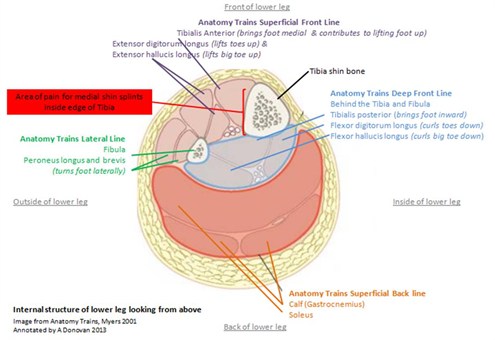Common problems helped by KMI
Do you suffer from shin splints?
It is common for athletes to suffer from shin splints. Many do not know they can be resolved through KMI Structural Integration.
Shin splints is a term used to describe medial tibial stress syndrome which is felt as pain and inflammation on the inside or more rarely, outside of the shin bone (tibia). For the lower leg to function correctly all the muscles need to freely slide over each other, expanding and contracting as the foot moves. When tightness or imbalance of these muscles occurs, fascial connections to the tibia become strained causing pain. What is fascia? Please click here for more information.
The diagram below shows the anatomy of the lower leg, looking internally from above, below the knee. The area of shin splints being identified by the red box on the left. The lower leg can be split into four fascial compartments published by Tom Myers in Anatomy Trains 2001.

Within each fascial compartmen t, each muscle has its own fascial wrapping. When running, the demand for function is greater, impact and planes of motion increase because of varying terrain and techniques. Incorrect function, over training and/or lack of stretching can lead to muscle tightness. When muscles don’t contract or expand as they should, the fascial wrappings which connect to the periosteum of the tibia become over stretched and strained causing inflammation and pain - shin splints.
t, each muscle has its own fascial wrapping. When running, the demand for function is greater, impact and planes of motion increase because of varying terrain and techniques. Incorrect function, over training and/or lack of stretching can lead to muscle tightness. When muscles don’t contract or expand as they should, the fascial wrappings which connect to the periosteum of the tibia become over stretched and strained causing inflammation and pain - shin splints.
To relieve shin splints, many sufferers rest and begin running gradually with the aim of improving muscle contractile ability and function. However this may take time and does not work for everyone. KMI Structural Integration can remove these fascial restrictions, release tightness held in the muscles of the lower leg and regain correct function.
How is KMI Structural Integration different to a normal massage?
Massage is excellent for restoring muscle function and improving blood flow. KMI Structural Integration works at a deeper fascial level. When looking at person with shin splints, the whole gait of the foot and leg is assessed. The aim is not only to relieve the pain of shin splints but also restore correct balance and function of the foot and leg which affects whole body balance and function.
To find out more, please contact Angela Donovan of Structural Balance
Common problems helped by KMI
Do you suffer from shin splints?
It is common for athletes to suffer from shin splints. Many do not know they can be resolved through KMI Structural Integration.
Shin splints is a term used to describe medial tibial stress syndrome which is felt as pain and inflammation on the inside or more rarely, outside of the shin bone (tibia). For the lower leg to function correctly all the muscles need to freely slide over each other, expanding and contracting as the foot moves. When tightness or imbalance of these muscles occurs, fascial connections to the tibia become strained causing pain. What is fascia? Please click here for more information.
The diagram below shows the anatomy of the lower leg, looking internally from above, below the knee. The area of shin splints being identified by the red box on the left. The lower leg can be split into four fascial compartments published by Tom Myers in Anatomy Trains 2001.

Within each fascial compartmen t, each muscle has its own fascial wrapping. When running, the demand for function is greater, impact and planes of motion increase because of varying terrain and techniques. Incorrect function, over training and/or lack of stretching can lead to muscle tightness. When muscles don’t contract or expand as they should, the fascial wrappings which connect to the periosteum of the tibia become over stretched and strained causing inflammation and pain - shin splints.
t, each muscle has its own fascial wrapping. When running, the demand for function is greater, impact and planes of motion increase because of varying terrain and techniques. Incorrect function, over training and/or lack of stretching can lead to muscle tightness. When muscles don’t contract or expand as they should, the fascial wrappings which connect to the periosteum of the tibia become over stretched and strained causing inflammation and pain - shin splints.
To relieve shin splints, many sufferers rest and begin running gradually with the aim of improving muscle contractile ability and function. However this may take time and does not work for everyone. KMI Structural Integration can remove these fascial restrictions, release tightness held in the muscles of the lower leg and regain correct function.
How is KMI Structural Integration different to a normal massage?
Massage is excellent for restoring muscle function and improving blood flow. KMI Structural Integration works at a deeper fascial level. When looking at person with shin splints, the whole gait of the foot and leg is assessed. The aim is not only to relieve the pain of shin splints but also restore correct balance and function of the foot and leg which affects whole body balance and function.
To find out more, please contact Angela Donovan of Structural Balance
Get in touch
Angela Radley (Donovan)
2 The Covert
York
YO24 1JN
Telephone: 07950 028 016





